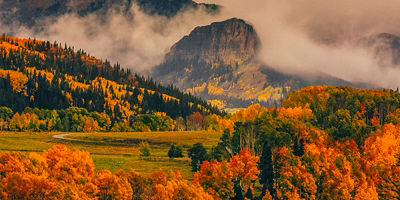
While most of the sinuous singletrack that resides inside our beautiful national parks is off limits to mountain bikers, the rise of gravel-ready adventure bikes has opened up a whole new under-appreciated resource in the park system: lonely, scenic gravel roads. While many of the paved thoroughfares inside our parks can be jam-packed with RVs and scenic cruisers, these gravel roads that traverse a park’s backcountry often go forgotten. That’s a good thing for you and your perfectly capable adventure bike. Here are five stunning national parks that are gravel-grinding playgrounds.
1. Acadia National Park - Maine
Acadia is famous for its dramatic coastline, but on the interior of the park, there’s a 45-mile-long system of historic carriage roads established by John D. Rockefeller Jr., that traverse the valleys and mountains. Rockefeller created the road system to explore his estate by horse. And though you’ll still share some of the paths with equestrians, cars aren’t allowed, so you can take in the grandeur of the landscape in peace. Expect 16-foot-wide crushed stone roads lined with uneven granite blocks dubbed “Rockefeller’s teeth.” Bridges will take you over streams as the roads cruise by cliffs, waterfalls, and sporadic long-range views of the interior of the park. You can create a variety of loops that encircle Eagle Lake as well as some of the smaller ponds in the park, allowing you to pick mileage that’s suitable for families or hardened adventurers.
More Info: nps.gov
2. Cuyahoga Valley National Park - Ohio
Cuyahoga Valley is one of the few national parks that has purpose-built singletrack for mountain bikers, but the real two-wheeled gem in this 33,000-acre park that preserves a slice of Ohio’s former wilderness and cultural heritage is the 20-mile-long, crushed limestone Towpath Trail along the Ohio and Erie Canal. The canal helped open the wilderness of Ohio to the eastern U.S., when it was finished in 1832, but now serves as an artery for exploration. A handful of trailheads along the trail make shorter trips possible and also give you the chance to hop off the trail into small, historic towns—meaning, the path is particularly family-friendly. The towpath also connects the national park to the Cleveland Metroparks system, providing the opportunity for longer rides. You’ll travel along the Cuyahoga River, aka “the crooked river,” over protected wetlands and past historic locks, with little to no elevation gain. You can also use the Cuyahoga Valley Scenic Railroad, which runs through the park, as a shuttle if you don’t want to ride an out-and-back—just wave down the train at various stations and hop on board with your bike.
More Info: nps.gov






















